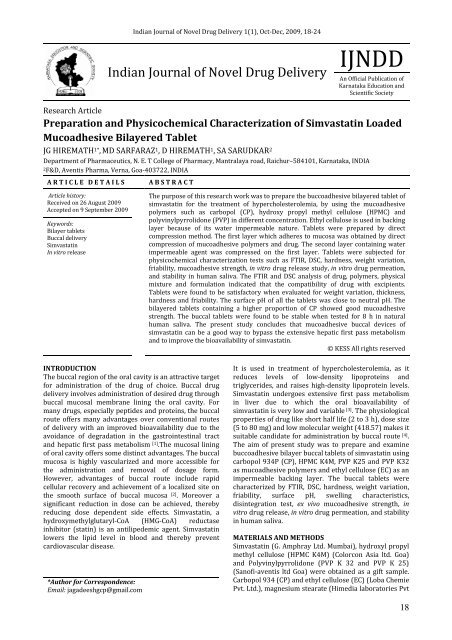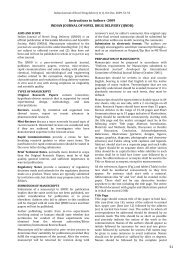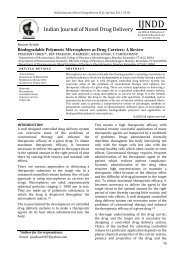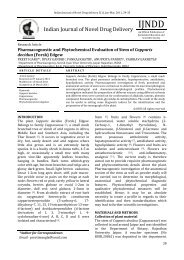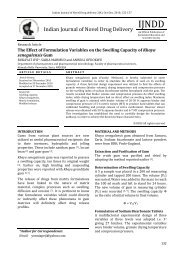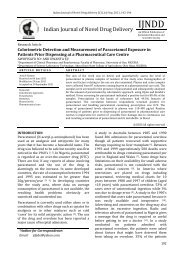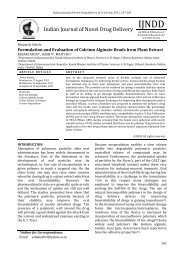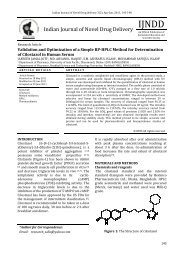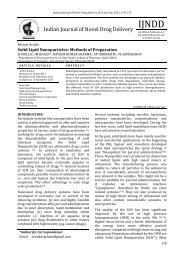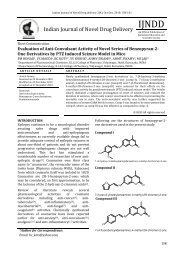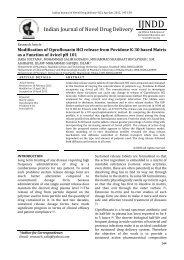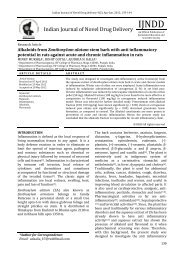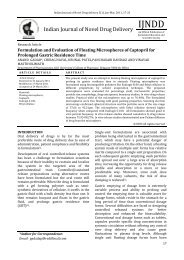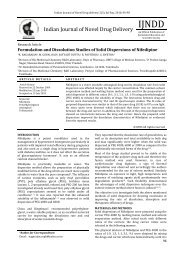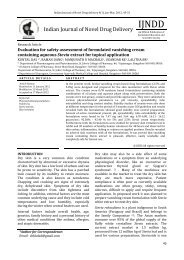Preparation and Physicochemical Characterization of Simvastatin ...
Preparation and Physicochemical Characterization of Simvastatin ...
Preparation and Physicochemical Characterization of Simvastatin ...
Create successful ePaper yourself
Turn your PDF publications into a flip-book with our unique Google optimized e-Paper software.
Indian Journal <strong>of</strong> Novel Drug Delivery 1(1), Oct-Dec, 2009, 18-24<br />
Indian Journal <strong>of</strong> Novel Drug Delivery<br />
IJNDD<br />
An Official Publication <strong>of</strong><br />
Karnataka Education <strong>and</strong><br />
Scientific Society<br />
Research Article<br />
<strong>Preparation</strong> <strong>and</strong> <strong>Physicochemical</strong> <strong>Characterization</strong> <strong>of</strong> <strong>Simvastatin</strong> Loaded<br />
Mucoadhesive Bilayered Tablet<br />
JG HIREMATH 1* , MD SARFARAZ 1 , D HIREMATH 1 , SA SARUDKAR 2<br />
Department <strong>of</strong> Pharmaceutics, N. E. T College <strong>of</strong> Pharmacy, Mantralaya road, Raichur–584101, Karnataka, INDIA<br />
2F&D, Aventis Pharma, Verna, Goa-403722, INDIA<br />
A R T I C L E D E T A I L S<br />
Article history:<br />
Received on 26 August 2009<br />
Accepted on 9 September 2009<br />
Keywords:<br />
Bilayer tablets<br />
Buccal delivery<br />
<strong>Simvastatin</strong><br />
In vitro release<br />
A B S T R A C T<br />
The purpose <strong>of</strong> this research work was to prepare the buccoadhesive bilayered tablet <strong>of</strong><br />
simvastatin for the treatment <strong>of</strong> hypercholesterolemia, by using the mucoadhesive<br />
polymers such as carbopol (CP), hydroxy propyl methyl cellulose (HPMC) <strong>and</strong><br />
polyvinylpyrrolidone (PVP) in different concentration. Ethyl cellulose is used in backing<br />
layer because <strong>of</strong> its water impermeable nature. Tablets were prepared by direct<br />
compression method. The first layer which adheres to mucosa was obtained by direct<br />
compression <strong>of</strong> mucoadhesive polymers <strong>and</strong> drug. The second layer containing water<br />
impermeable agent was compressed on the first layer. Tablets were subjected for<br />
physicochemical characterization tests such as FTIR, DSC, hardness, weight variation,<br />
friability, mucoadhesive strength, in vitro drug release study, in vitro drug permeation,<br />
<strong>and</strong> stability in human saliva. The FTIR <strong>and</strong> DSC analysis <strong>of</strong> drug, polymers, physical<br />
mixture <strong>and</strong> formulation indicated that the compatibility <strong>of</strong> drug with excipients.<br />
Tablets were found to be satisfactory when evaluated for weight variation, thickness,<br />
hardness <strong>and</strong> friability. The surface pH <strong>of</strong> all the tablets was close to neutral pH. The<br />
bilayered tablets containing a higher proportion <strong>of</strong> CP showed good mucoadhesive<br />
strength. The buccal tablets were found to be stable when tested for 8 h in natural<br />
human saliva. The present study concludes that mucoadhesive buccal devices <strong>of</strong><br />
simvastatin can be a good way to bypass the extensive hepatic first pass metabolism<br />
<strong>and</strong> to improve the bioavailability <strong>of</strong> simvastatin.<br />
© KESS All rights reserved<br />
INTRODUCTION<br />
The buccal region <strong>of</strong> the oral cavity is an attractive target<br />
for administration <strong>of</strong> the drug <strong>of</strong> choice. Buccal drug<br />
delivery involves administration <strong>of</strong> desired drug through<br />
buccal mucosal membrane lining the oral cavity. For<br />
many drugs, especially peptides <strong>and</strong> proteins, the buccal<br />
route <strong>of</strong>fers many advantages over conventional routes<br />
<strong>of</strong> delivery with an improved bioavailability due to the<br />
avoidance <strong>of</strong> degradation in the gastrointestinal tract<br />
<strong>and</strong> hepatic first pass metabolism [1] .The mucosal lining<br />
<strong>of</strong> oral cavity <strong>of</strong>fers some distinct advantages. The buccal<br />
mucosa is highly vascularized <strong>and</strong> more accessible for<br />
the administration <strong>and</strong> removal <strong>of</strong> dosage form.<br />
However, advantages <strong>of</strong> buccal route include rapid<br />
cellular recovery <strong>and</strong> achievement <strong>of</strong> a localized site on<br />
the smooth surface <strong>of</strong> buccal mucosa [2] . Moreover a<br />
significant reduction in dose can be achieved, thereby<br />
reducing dose dependent side effects. <strong>Simvastatin</strong>, a<br />
hydroxymethylglutaryl-CoA (HMG-CoA) reductase<br />
inhibitor (statin) is an antilipedemic agent. <strong>Simvastatin</strong><br />
lowers the lipid level in blood <strong>and</strong> thereby prevent<br />
cardiovascular disease.<br />
*Author for Correspondence:<br />
Email: jagadeeshgcp@gmail.com<br />
It is used in treatment <strong>of</strong> hypercholesterolemia, as it<br />
reduces levels <strong>of</strong> low-density lipoproteins <strong>and</strong><br />
triglycerides, <strong>and</strong> raises high-density lipoprotein levels.<br />
<strong>Simvastatin</strong> undergoes extensive first pass metabolism<br />
in liver due to which the oral bioavailability <strong>of</strong><br />
simvastatin is very low <strong>and</strong> variable [3] . The physiological<br />
properties <strong>of</strong> drug like short half life (2 to 3 h), dose size<br />
(5 to 80 mg) <strong>and</strong> low molecular weight (418.57) makes it<br />
suitable c<strong>and</strong>idate for administration by buccal route [4] .<br />
The aim <strong>of</strong> present study was to prepare <strong>and</strong> examine<br />
buccoadhesive bilayer buccal tablets <strong>of</strong> simvastatin using<br />
carbopol 934P (CP), HPMC K4M, PVP K25 <strong>and</strong> PVP K32<br />
as mucoadhesive polymers <strong>and</strong> ethyl cellulose (EC) as an<br />
impermeable backing layer. The buccal tablets were<br />
characterized by FTIR, DSC, hardness, weight variation,<br />
friability, surface pH, swelling characteristics,<br />
disintegration test, ex vivo mucoadhesive strength, in<br />
vitro drug release, in vitro drug permeation, <strong>and</strong> stability<br />
in human saliva.<br />
MATERIALS AND METHODS<br />
<strong>Simvastatin</strong> (G. Amphray Ltd. Mumbai), hydroxyl propyl<br />
methyl cellulose (HPMC K4M) (Colorcon Asia ltd. Goa)<br />
<strong>and</strong> Polyvinylpyrrolidone (PVP K 32 <strong>and</strong> PVP K 25)<br />
(San<strong>of</strong>i-aventis ltd Goa) were obtained as a gift sample.<br />
Carbopol 934 (CP) <strong>and</strong> ethyl cellulose (EC) (Loba Chemie<br />
Pvt. Ltd.), magnesium stearate (Himedia laboratories Pvt<br />
18
JG Hiremath et al / Indian Journal <strong>of</strong> Novel Drug Delivery 1(1), Oct-Dec, 2009, 18-24<br />
ltd. Mumbai) <strong>and</strong> sodium saccharin (S.D. fine chem.<br />
Boisar) were obtained from commercial sources. All<br />
other reagents <strong>and</strong> chemicals used were <strong>of</strong> analytical<br />
grade.<br />
<strong>Preparation</strong> <strong>of</strong> buccal tablets<br />
Mucoadhesive bilayer tablets were prepared by a direct<br />
compression method [5, 6] . Various batches <strong>of</strong> buccal<br />
tablets were prepared by varying the concentration <strong>of</strong><br />
CP, HPMC K4M, PVP K25 <strong>and</strong> PVP K32. The composition<br />
for core layer <strong>and</strong> backing layer is shown in Table 1. The<br />
drug <strong>and</strong> mucoadhesive polymer mixture (core layer)<br />
was prepared by homogeneously mixing the drug with<br />
CP, HPMC K4M, PVP K25, PVP K32 <strong>and</strong> magnesium<br />
stearate in a glass mortar for 15 m. The mixture (150<br />
mg) was then compressed using indigenously developed<br />
<strong>and</strong> st<strong>and</strong>ardized stainless steel punches <strong>and</strong> die (Fig. 1)<br />
in pellet press. The upper punch was raised <strong>and</strong> the<br />
backing layer <strong>of</strong> EC granules (50 mg) was placed on the<br />
first layer; the 2 layers were then compressed to form<br />
mucoadhesive bilayer tablet. Each tablet weighed around<br />
200 mg with a thickness <strong>of</strong> 2.0 to 2.1 mm.<br />
FTIR analysis<br />
Infrared spectroscopy (Model-V-5300, JASCO, Japan) was<br />
performed for pure drug, pure polymers, physical<br />
mixture <strong>of</strong> drug <strong>and</strong> polymers <strong>and</strong> drug loaded buccal<br />
tablets. All the samples were mixed with KBr <strong>and</strong><br />
vacuum packed to obtain pellets <strong>of</strong> the material, which<br />
were analyzed. All the spectra acquired scans between<br />
400 to 4000 cm -1 at a resolution <strong>of</strong> 4 cm -1 [4] .<br />
Table 1: Composition <strong>of</strong> simvastatin buccal tablets<br />
A. Composition for core layer<br />
Formulation code<br />
Drug<br />
(mg)<br />
Carbopol<br />
934<br />
(mg)<br />
HPMC<br />
K4M<br />
(mg)<br />
DSC analysis<br />
DSC studies were carried out using differential scanning<br />
calorimeter equipped with an intracooler (Mettler-<br />
Toledo, Switzerl<strong>and</strong>). Indium/Zinc st<strong>and</strong>ards were used<br />
to calibrate the DSC temperature <strong>and</strong> enthalpy scale. The<br />
samples (Pure simvastatin, polymers, physical mixture<br />
<strong>and</strong> formulation) were sealed in aluminum pans <strong>and</strong><br />
heated at a constant rate <strong>of</strong> 20 0 C/m over a temperature<br />
range <strong>of</strong> 20-150 0 C. Inert atmosphere was maintained by<br />
purging nitrogen gas at flow rate <strong>of</strong> 50 ml/m [4] .<br />
Surface pH determination<br />
The surface pH <strong>of</strong> the buccal tablets was determined to<br />
investigate the chances <strong>of</strong> any side effects. As an acidic or<br />
alkaline pH may irritate the buccal mucosa, the surface<br />
pH should be close to neutral. The method used to<br />
determine surface pH <strong>of</strong> the formulation was according<br />
the reported method [6] . In briefly, a combined glass<br />
electrode was used to measure the surface pH. The tablet<br />
was allowed to swell by keeping them in contact with 1<br />
ml <strong>of</strong> distilled water (pH 6.6 ± 0.05) for 2 h <strong>and</strong> pH was<br />
noted by bringing the electrode in contact with the<br />
surface <strong>of</strong> the formulation <strong>and</strong> allowing it to equilibrate<br />
for 1 m [6] .<br />
Swelling studies<br />
The swelling property <strong>of</strong> buccal tablets was evaluated by<br />
determining percentage hydration. Each tablet was<br />
weighted (W1) <strong>and</strong> placed in phosphate buffer pH 6.6 for<br />
predetermined time intervals. After immersion for a<br />
specified time, tablets were wiped out to remove excess<br />
<strong>of</strong> surface water by using filter paper <strong>and</strong> again weighted<br />
(W2). Percent hydration was calculated by using<br />
following formula [7] .<br />
W2-W1<br />
% hydration = -----------------------× 100<br />
W1<br />
PVP K<br />
25<br />
(mg)<br />
PVP<br />
K 32<br />
(mg)<br />
Mg. Stearate<br />
(mg)<br />
F1 5 71.50 71.50 - - 2.00 150<br />
F2 5 47.66 95.34 - - 2.00 150<br />
F3 5 95.34 47.66 - - 2.00 150<br />
F4 5 57.20 85.80 - - 2.00 150<br />
F5 5 71.50 - 71.50 - 2.00 150<br />
F6 5 47.66 - 95.34 - 2.00 150<br />
F7 5 95.34 - 47.66 - 2.00 150<br />
F8 5 57.20 - 85.80 - 2.00 150<br />
F9 5 71.50 - - 71.50 2.00 150<br />
F10 5 47.66 - - 95.34 2.00 150<br />
F11 5 95.34 - - 47.66 2.00 150<br />
F12 5 57.20 - - 85.80 2.00 150<br />
B. Composition for backing layer<br />
Ethyl cellulose (mg) Carbopol 934<br />
(mg)<br />
PVP K 32<br />
(mg)<br />
Sodium<br />
saccharin<br />
(mg)<br />
Tartrazine (mg)<br />
22.50 6.25 18.75 2.5 0.05 50<br />
Total<br />
weight<br />
(mg)<br />
Total weight<br />
(mg)<br />
19
JG Hiremath et al / Indian Journal <strong>of</strong> Novel Drug Delivery 1(1), Oct-Dec, 2009, 18-24<br />
2.3 cm<br />
2.6 cm<br />
2 cm<br />
3.9 cm<br />
8 mm<br />
8.1 mm<br />
3.3 cm<br />
8 mm<br />
3.3 cm<br />
4.9 cm Upper Punch<br />
2.3 cm Die<br />
3.2 cm Lower Punch<br />
Figure 1: Indigenously developed <strong>and</strong> st<strong>and</strong>ardized<br />
punches <strong>and</strong> die for development <strong>of</strong> buccal tablets<br />
Ex vivo mucoadhesive strength<br />
Bioadhesive strength <strong>of</strong> the buccal tablets was measured<br />
on modified physical balance followed by a reported<br />
method [8] . A modified physical balance was used for<br />
determining the ex vivo mucoadhesive strength <strong>of</strong><br />
prepared buccal tablets. Fresh sheep buccal mucosa was<br />
obtained from a local slaughterhouse (Approved by<br />
institutional ethical committee, Dept. <strong>of</strong> Pharmacology,<br />
NET College <strong>of</strong> Pharmacy, Raichur, Karnataka, India).<br />
The mucosal membrane was separated by removing<br />
underlying fat <strong>and</strong> loose tissues. The membrane was<br />
washed with distilled water <strong>and</strong> then with phosphate<br />
buffer pH 6.6 at 37 ± 1 0 C. Sheep buccal mucosa was tied<br />
to the glass petri dish, which was filled with phosphate<br />
buffer so that it just touched the mucosal surface. The<br />
buccal tablet was stuck to the lower side <strong>of</strong> a thread with<br />
cyanoacrylate adhesive. The two sides <strong>of</strong> the balance<br />
were made equal by keeping a 5 g weight on the right<br />
h<strong>and</strong> pan. Next, weight <strong>of</strong> 5 g was removed from the<br />
right h<strong>and</strong> pan, which lowered the pan along with the<br />
tablet over the mucosa. The balance was kept in this<br />
position for 5 m contact time. Then weight was added<br />
slowly to the right h<strong>and</strong> pan until the tablet detached<br />
from the mucosal surface [6, 8] .<br />
Disintegration test<br />
The disintegration pattern <strong>of</strong> each mucoadhesive buccal<br />
tablet was determined by immersing the tablet in a glass<br />
petri dish containing 20 to 25 ml <strong>of</strong> water at room<br />
temperature (37 ± 1 0 C). The morphological changes <strong>of</strong><br />
each buccal tablet are observed [9] .<br />
In vitro drug release studies<br />
To study the drug release from the bilayered tablets, the<br />
United States Pharmacopeia (USP) XXIII rotating paddle<br />
method was used. The dissolution medium used<br />
consisted <strong>of</strong> 500 ml <strong>of</strong> phosphate buffer (pH 6.6)<br />
containing 0.5 % dodecyl sodium sulphate. The release<br />
was performed at 37 ± 0.5 0 C, with a rotation speed <strong>of</strong> 50<br />
rpm. The backing layer <strong>of</strong> buccal tablet was attached to<br />
the glass slide with cyanoacrylate adhesive. The glass<br />
slide was placed to the bottom <strong>of</strong> the dissolution vessel.<br />
At a predetermined time intervals, samples (5 ml) were<br />
withdrawn <strong>and</strong> replaced with fresh medium. The<br />
samples were filtered through whatman filter paper <strong>and</strong><br />
after appropriate dilution analyzed by UV<br />
spectrophotometer (Pharmaspec-17, Shimadzu, Japan)<br />
at 238 nm [6, 10] .<br />
In vitro drug permeation study<br />
The in vitro buccal drug permeation study <strong>of</strong> simvastatin<br />
through the sheep buccal mucosa was performed using<br />
keshary chien type glass diffusion cell at 37 ± 0.2 0 C.<br />
Fresh sheep buccal mucosa was mounted between the<br />
donor <strong>and</strong> receptor compartments. The buccal tablet was<br />
placed with the core facing the mucosa <strong>and</strong> the<br />
compartments clamped together. The donor<br />
compartment was filled with 5 ml <strong>of</strong> phosphate buffer<br />
pH 6.6. The receptor compartment (50 ml capacity) was<br />
filled with phosphate buffer pH 7.4, <strong>and</strong> the<br />
hydrodynamics in the receptor compartment was<br />
maintained by stirring with a magnetic bead at 50 rpm.<br />
Aliquots <strong>of</strong> 1 ml sample was withdrawn from the<br />
receptor compartment at predetermined time intervals<br />
<strong>and</strong> analyzed at 238 nm using UV spectrophotometer [6] .<br />
Stability study in saliva<br />
The stability study <strong>of</strong> prepared <strong>and</strong> optimized buccal<br />
tablets was performed in fresh human saliva. The ethics<br />
committee <strong>of</strong> the NET College <strong>of</strong> pharmacy, India,<br />
approved the study <strong>and</strong> subjects were determined to be<br />
in good health before commencement <strong>of</strong> the study. The<br />
written consent was obtained from human volunteers<br />
for collecting the fresh saliva. Buccal tablets were placed<br />
in separate a petri dishes containing 5 ml <strong>of</strong> natural<br />
human saliva <strong>and</strong> placed in a temperature controlled<br />
oven at 37 ± 0.2 0 C for 8 h. At predetermined time<br />
intervals (up to 8 h); the tablets were examined for<br />
changes in color, shape, <strong>and</strong> drug content [11] .<br />
RESULTS AND DISCUSSION<br />
In the present work, an antihyperlipidemic drug<br />
simvastatin <strong>and</strong> the mucoadhesive polymers were<br />
selected on the basis <strong>of</strong> bioadhesive property, nontoxicity,<br />
non-irritancy, stability <strong>and</strong> compatibility with<br />
the drug for the development <strong>of</strong> buccoadhesive tablets.<br />
Core layer was composed <strong>of</strong> drug <strong>and</strong> polymers, i.e.<br />
combinations <strong>of</strong> CP 934P: HPMC K4M, CP 934P: PVP K25,<br />
CP 934P: PVP K32 in varying ratios (1:1, 1:2, 2:1, <strong>and</strong><br />
2:3). Ethyl cellulose was selected as backing layer<br />
compound due to its water impermeable nature [12] . CP<br />
934P <strong>and</strong> PVP K32 (1:3) was added in to backing layer to<br />
avoid premature cracking. Sodium saccharin was added<br />
as sweetening agent to allow good mouth feel <strong>and</strong><br />
coloring agent (tartrazine) was also incorporated to<br />
distinguish the backing layer from core layer. All buccal<br />
tablets observed were round in shape, small in size (8<br />
20
JG Hiremath et al / Indian Journal <strong>of</strong> Novel Drug Delivery 1(1), Oct-Dec, 2009, 18-24<br />
mm diameter) with flat surface <strong>and</strong> having a good<br />
physical appearance. Due to the color difference between<br />
two layers (yellow <strong>and</strong> white), tablet became easily<br />
distinguishable <strong>and</strong> attractive in nature. FTIR<br />
spectroscopic analysis was carried out to ascertain<br />
whether there is any interaction between drug <strong>and</strong><br />
excipients used (Fig. 2).<br />
Figure 2: FTIR spectrum <strong>of</strong> pure drug, polymers,<br />
physical mixture <strong>and</strong> formulation. (A) Pure simvastatin,<br />
(B) carbopol 934, (C) HPMC K4M, (D) PVP K32, (E) PVP<br />
K25, (F) ethyl cellulose, (G) physical mixture, (H)<br />
optimized formulation<br />
Figure 3: DSC thermograms <strong>of</strong>, (A) simvastatin, (B)<br />
carbopol 934, (C) PVP K32, (D) HPMC K4M, (E) ethyl<br />
cellulose, (F) physical mixture, (G) optimized<br />
formulation, (H) PVP K25<br />
The IR spectra <strong>of</strong> pure drug shows characteristic<br />
functional peaks at 2929.1, 1709.8, 1369.1, 1269.0, <strong>and</strong><br />
1055.6 cm -1 , while physical mixture shows characteristic<br />
peaks at 2928.5, 1712.7, 1366.0, 1268.4, 1062.7 cm -1<br />
with negligible shift in wave numbers. The negligible<br />
shift in wave numbers might be due to presence <strong>of</strong><br />
amorphous nature <strong>of</strong> polymers <strong>and</strong> excipients used. The<br />
IR spectra <strong>of</strong> optimized formulation show characteristic<br />
functional peaks at 2928.5, 1692.8, 1372.0, 1268.4 <strong>and</strong><br />
1057.1 cm -1 . The similarity in the peaks indicated that<br />
the compatibility <strong>of</strong> drug with excipients. The obtained<br />
results from FTIR studies were also proved by DSC<br />
analysis. DSC thermogram <strong>of</strong> simvastatin, polymers,<br />
physical mixture <strong>and</strong> formulation was carried out to<br />
study change in thermal properties <strong>of</strong> drug (Fig. 3). Pure<br />
simvastatin thermogram was a single, sharp melting<br />
endotherm at 139.5 0 C. There is no endothermic peak<br />
appearance in case <strong>of</strong> all the polymers <strong>and</strong> excipients<br />
due to the amorphous nature <strong>of</strong> polymers <strong>and</strong> excipients.<br />
In the physical mixture, the sharp peak was observed at<br />
134.56 0 C with negligible change in endotherm. This<br />
clearly indicates that, the excipients used to formulate<br />
buccal tablet had no effect on thermal properties <strong>of</strong> drug.<br />
DSC thermogram <strong>of</strong> formulation was compared with<br />
pure drug <strong>and</strong> physical mixture. A sharp melting<br />
endothermic peak appeared at 141.96 0 C. The slight<br />
change in melting temperature <strong>of</strong> drug may be attributed<br />
due to addition <strong>of</strong> amorphous excipients. Thus the<br />
obtained results clearly indicated that the excipients <strong>and</strong><br />
method <strong>of</strong> preparation <strong>of</strong> buccal tablet had no effect on<br />
thermal properties <strong>of</strong> the drug. Table 2 shows the<br />
evaluation <strong>of</strong> different parameters for prepared buccal<br />
tablet. Mucoadhesive bilayered tablets <strong>of</strong> simvastatin<br />
were found to be satisfactory when evaluated for<br />
average thickness (2.01 ± 0.01 mm), hardness (6.20 ±<br />
0.47 kg/cm 2 ), weight variation (200 ± 0.98 mg), friability<br />
(0.321 ± 0.11%) <strong>and</strong> drug content (94.97 ± 1.68%).<br />
Surface pH determination<br />
Surface pH <strong>of</strong> bilayered tablets was found to be in<br />
between 6.23 ± 0.05 to 6.66 ± 0.25. The investigated<br />
results indicated that the developed buccal tablets will<br />
not cause any irritation to mucosal surface.<br />
Swelling studies<br />
Appropriate swelling behavior <strong>of</strong> a buccal adhesive<br />
system is an essential property for uniform <strong>and</strong><br />
prolonged release <strong>of</strong> drug <strong>and</strong> effective mucoadhesion<br />
[11]<br />
. Swelling index is increased as the weight gain by<br />
tablet is increased proportionally with the rate <strong>of</strong><br />
hydration [13] . Swelling indices <strong>of</strong> the prepared buccal<br />
tablets containing CP: HPMC <strong>and</strong> CP: PVP increases with<br />
increasing amount <strong>of</strong> CP. The swelling index for buccal<br />
tablets containing CP:HPMC was found to be in between<br />
63.05 ± 1.92 to 82.65 ± 1.45% respectively, in which the<br />
ratio 2:1 <strong>of</strong> CP: HPMC exhibit highest value (82.65%).<br />
For tablets containing CP: PVP K25 (F5-F8) swelling<br />
index was found to be in between 54.27 ± 2.33 to 77.77 ±<br />
0.47% respectively, while for CP: PVP K32 (F9-F12) in<br />
between 55.61 ± 1.00 to 81.81 ± 1.75% respectively.<br />
Ex vivo mucoadhesive strength<br />
Mucoadhesion may be defined as the adhesion between<br />
a polymer <strong>and</strong> mucus. The strength <strong>of</strong> mucoadhesion is<br />
affected by various factors such as molecular weight <strong>of</strong><br />
polymers, contact time with mucus, swelling rate <strong>of</strong> the<br />
polymer, <strong>and</strong> biological membrane used in the study [14] .<br />
In this study, sheep buccal mucosa was used as biological<br />
membrane for mucoadhesion. The bioadhesive strength<br />
<strong>of</strong> buccal tablets was found to be in between 20.33 ± 1.52<br />
to 27.66 ± 0.57 g. Bilayered tablets containing CP <strong>and</strong><br />
HPMC in ratio <strong>of</strong> 2:1 (F3) exhibited the highest<br />
bioadhesive strength (27.67 ± 0.57 g). The bilayered<br />
tablets containing a higher proportion <strong>of</strong> CP showed<br />
good mucoadhesive strength. The high bioadhesive<br />
strength <strong>of</strong> CP may be due to the formation <strong>of</strong> secondary<br />
bioadhesion bonds with mucin <strong>and</strong> interpenetration <strong>of</strong><br />
the polymer chains in the interfacial region, while the<br />
other polymers only undergo superficial bioadhesion [15] .<br />
21
JG Hiremath et al / Indian Journal <strong>of</strong> Novel Drug Delivery 1(1), Oct-Dec, 2009, 18-24<br />
Table 2: Evaluation parameters <strong>of</strong> simvastatin buccal tablet formulations F1-F12<br />
Formulation Thickness<br />
Code (mm)<br />
Hardness<br />
(Kg/cm 2 )<br />
Friability<br />
(%)<br />
Average<br />
weight<br />
(mg)<br />
Surface pH<br />
Mucoadhesive<br />
strength<br />
(gm)<br />
Drug<br />
content<br />
(%)<br />
Disintegration<br />
time (h)<br />
F1 2.02 ± 0.01 6.40 ± 0.69 0.370 ± 0.14 200.00 ± 1.73 6.36 ± 0.05 23.67 ± 1.52 91.59 ± 1.46 15.00 ± 1.00<br />
F2 2.01 ± 0.01 6.56 ± 0.40 0.374 ± 0.15 199.34 ± 0.57 6.56 ± 0.05 20.33 ± 0.57 97.35 ± 1.30 11.00 ± 0.50<br />
F3 2.01 ± 0.01 5.83 ± 0.35 0.222 ± 0.10 200.34 ± 0.57 6.43 ± 0.23 27.67 ± 1.52 98.17 ± 0.88 16.00 ± 0.20<br />
F4 2.02 ± 0.01 5.60 ± 0.60 0.344 ± 0.17 198.67 ± 0.57 6.46 ± 0.05 21.33 ± 0.57 98.70 ± 0.84 14.00 ± 1.00<br />
F5 2.01 ± 0.01 6.13 ± 0.61 0.329 ± 0.10 199.34 ± 1.52 6.56 ± 0.28 20.67 ± 1.15 96.17 ± 1.86 13.00 ± 1.00<br />
F6 2.01 ± 0.00 6.40 ± 0.52 0.359 ± 0.09 200.67 ± 0.57 6.46 ± 0.11 18.00 ± 1.00 92.65 ± 2.00 10.00 ± 0.50<br />
F7 2.01 ± 0.01 6.26 ± 0.11 0.207 ± 0.06 200.00 ± 1.73 6.66 ± 0.25 22.33 ± 0.57 93.55 ± 2.49 14.00 ± 1.00<br />
F8 2.02 ± 0.02 6.33 ± 0.50 0.316 ± 0.14 199.67 ± 0.57 6.60 ± 0.34 20.33 ± 0.57 94.02 ± 0.72 12.00 ± 0.50<br />
F9 2.02 ± 0.02 5.80 ± 0.20 0.325 ± 0.15 199.00 ± 1.00 6.36 ± 0.23 24.33 ± 1.52 93.10 ± 1.97 13.50 ± 0.50<br />
F10 2.02 ± 0.02 6.53 ± 0.61 0.364 ± 0.14 200.34 ± 1.15 6.43 ± 0.05 22.67 ± 2.08 94.64 ± 2.50 11.00 ± 1.00<br />
F11 2.01 ± 0.01 6.20 ± 0.60 0.265 ± 0.08 200.34 ± 1.15 6.23 ± 0.05 26.67 ± 1.52 95.06 ± 2.16 14.00 ± 1.00<br />
F12 2.01 ± 0.01 6.40 ± 0.52 0.285 ± 0.10 198.67 ± 0.57 6.53 ± 0.15 23.67 ± 1.52 95.73 ± 3.08 12.00 ± 1.00<br />
Disintegration test<br />
The disintegration test for buccal tablet is required to<br />
check the integrity <strong>of</strong> formulation. When tablets<br />
immersed in water initially it hydrates <strong>and</strong> swells for<br />
longer time <strong>and</strong> then disintegrates slowly. Disintegration<br />
time for prepared buccal tablets was found to be in<br />
between 10.00 ± 0.50 to 16.00 ± 0.20 h. The obtained<br />
results indicated that disintegration time increases as<br />
amount <strong>of</strong> carbopol increases due to its high molecular<br />
weight <strong>and</strong> viscosity<br />
In vitro drug release studies<br />
The in vitro dissolution was carried out in phosphate<br />
buffer pH 6.6 containing 0.5 % dodecyl sodium sulphate.<br />
In vitro dissolution studies clearly indicated that the<br />
formulation containing CP 934P: HPMC K4M showed<br />
higher drug release as compared to other formulations<br />
containing CP 934P: PVP K25 <strong>and</strong> CP 934P: PVP K32. The<br />
drug release pr<strong>of</strong>ile <strong>of</strong> formulations F1-F4, F5-F8, <strong>and</strong><br />
F9-F12 have been well depicted in Fig.4, 5 <strong>and</strong> 6<br />
respectively. The cumulative percentage drug released<br />
from formulations F1-F4 was found to be 64.07 ± 0.24,<br />
56.60 ± 0.30, 66.76 ± 0.07, <strong>and</strong> 60.57 ± 0.23%,<br />
respectively, while for F5-F8 the drug release was 53.54<br />
± 0.07, 47.73 ± 0.24, 57.19 ± 0.08 <strong>and</strong> 50.66 ± 0.07%,<br />
respectively. The formulations F9-F12 showed that the<br />
drug release 61.35 ± 0.26, 53.56 ± 0.09, 63.11 ± 0.24 <strong>and</strong><br />
57.06 ± 0.23%, respectively. The maximum drug release<br />
was found in formulation F3 (66.76 ± 0.07%). The in<br />
vitro drug release studies revealed that the release <strong>of</strong><br />
simvastatin from different formulations varies with<br />
characteristics <strong>and</strong> composition <strong>of</strong> matrix forming<br />
polymer. The release rate <strong>of</strong> simvastatin decreased with<br />
increasing amount <strong>of</strong> HPMC K4M <strong>and</strong> PVP K25 <strong>and</strong> PVP<br />
K32. The decrease in the amount <strong>of</strong> drug released in<br />
formulations F2 (56.60 ± 0.30%), F6 (47.73 ± 0.24%)<br />
<strong>and</strong> F10 (53.56 ± 0.09%) may be attributed due to<br />
increase in proportion <strong>of</strong> HPMC <strong>and</strong> PVP, which form<br />
complex matrix network <strong>and</strong> leads to delay in drug<br />
release. Carbopol is more hydrophilic than HPMC <strong>and</strong><br />
PVP; it swells rapidly, therefore decrease in carbopol<br />
content may delay in the drug release [5] . HPMC have<br />
greater swelling properties than PVP, hence the drug<br />
release from CP: HPMC is greater as compared to CP:<br />
PVP formulations. Drug release rate was increased with<br />
increasing amount <strong>of</strong> hydrophilic polymer. Another<br />
explanation includes, high water uptake which leads to<br />
considerable swelling <strong>of</strong> polymer <strong>and</strong> causes drug to<br />
diffuse out from polymer matrix. Moreover the<br />
hydrophilic polymers would leach out <strong>and</strong> hence creates<br />
more pores <strong>and</strong> channels for drug to diffuse out from the<br />
device [16] . F9 was found to be best formulation on the<br />
basis <strong>of</strong> in vitro drug release mechanism, optimum<br />
swelling index <strong>and</strong> good bioadhesive strength. The drug<br />
release from optimized formulation F9 was found to be<br />
61.35 ± 0.26% at 8 h. Hence F9 is selected for further<br />
studies like in vitro drug permeation <strong>and</strong> stability<br />
studies. Formulation F3 selected for in vitro permeation<br />
studies depending on its maximum drug release. The<br />
obtained in vitro drug release pattern <strong>of</strong> all the<br />
formulations were also subjected to different kinetic<br />
models, such as zero order, first order, higuchi matrix,<br />
peppas <strong>and</strong> hixson crowell models to predict the<br />
mechanism <strong>of</strong> drug release. The obtained results have<br />
been shown in Table 3. The values <strong>of</strong> n were estimated<br />
from peppas model <strong>and</strong> these values were in between<br />
0.5 <strong>and</strong> 1.0, indicated that the release <strong>of</strong> simvastatin<br />
from the prepared buccal tablets is by non-fickian<br />
diffusion <strong>and</strong> erosion mechanism. A water soluble drug<br />
incorporated in a matrix is mainly released by diffusion,<br />
while for a low water soluble drug the self-erosion <strong>of</strong> the<br />
matrix will be the principal mechanism [17] . <strong>Simvastatin</strong><br />
is low water soluble drug, hence the release <strong>of</strong> drug is<br />
mainly depends on the self erosion <strong>of</strong> matrix.<br />
22
JG Hiremath et al / Indian Journal <strong>of</strong> Novel Drug Delivery 1(1), Oct-Dec, 2009, 18-24<br />
Table 3: Model fitting for simvastatin buccal tablet formulation F1-F12<br />
Formulation code<br />
Zero order<br />
Qt= Qo+Kot<br />
First order<br />
ln Qt= lnQo+ Kot<br />
Higuchi<br />
Qt=KH sq.t<br />
Krosmeyer-Peppas<br />
Qt/Qinf=Kk t n<br />
Hixon<br />
crowell<br />
n<br />
(Value)<br />
R 2 R 2 R 2 R 2 R 2<br />
F1 0.9895 0.9862 0.9587 0.9971 0.9935 0.7608<br />
F2 0.9613 0.9957 0.9978 0.9985 0.9922 0.5578<br />
F3 0.9307 0.9831 0.9804 0.9691 0.9696 0.7243<br />
F4 0.9330 0.9971 0.9977 0.9980 0.9955 0.5379<br />
F5 0.9774 0.9914 0.9728 0.9943 0.9929 0.6198<br />
F6 0.9820 0.9990 0.9717 0.9986 0.9984 0.7288<br />
F7 0.9783 0.9977 0.9752 0.9992 0.9979 0.7089<br />
F8 0.9372 0.9854 0.9925 0.9938 0.9791 0.6198<br />
F9 0.9094 0.9859 0.9958 0.9866 0.9773 0.5513<br />
F10 0.9497 0.9924 0.9896 0.9929 0.9873 0.6495<br />
F11 0.9367 0.9975 0.9977 0.9993 0.9974 0.5412<br />
F12 0.9193 0.9903 0.9976 0.9939 0.9860 0.5386<br />
Figure 4: In vitro drug release pr<strong>of</strong>ile <strong>of</strong> simvastatin<br />
buccaltablet formulation F1 (♦), F2 (■), F3 (▲), F4 (×)<br />
Figure 6: In vitro drug release pr<strong>of</strong>ile <strong>of</strong> simvastatin<br />
buccal tablet formulation F9 (♦), F10 (■), F11 (▲), F12<br />
(×)<br />
Figure 5: In vitro drug release pr<strong>of</strong>ile <strong>of</strong> simvastatin<br />
buccal tablet formulation F5 (♦), F6 (■), F7 (▲), F8 (×)<br />
Figure 7: Comparison <strong>of</strong> in vitro dissolution pr<strong>of</strong>ile <strong>of</strong><br />
simvastatin (♦), F3 (■), F9 (×) <strong>and</strong> in vitro permeation <strong>of</strong><br />
SIM (▲), F3 (ж), F9 (-)<br />
23
JG Hiremath et al / Indian Journal <strong>of</strong> Novel Drug Delivery 1(1), Oct-Dec, 2009, 18-24<br />
In vitro drug permeation study<br />
The prepared <strong>and</strong> optimized buccal tablet formulations<br />
F3 <strong>and</strong> F9 as well as pure drug were subjected for in<br />
vitro drug permeation through sheep buccal mucosa.<br />
Fig. 7 shows the comparison <strong>of</strong> in vitro dissolution<br />
pr<strong>of</strong>ile <strong>and</strong> in vitro permeation <strong>of</strong> pure drug,<br />
formulations F3 <strong>and</strong> F9. The in vitro permeation <strong>of</strong><br />
simvastatin was found to be 63.38±0.32% in 8 h. The<br />
average flux <strong>of</strong> simvastatin was found to be 0.126<br />
mg/cm -1 /hr -1 . Formulation F3 showed 56.03 ± 0.25%<br />
<strong>and</strong> Formulation F9 showed 53.14 ± 0.14% <strong>of</strong> drug<br />
permeated in 8 hours through sheep buccal mucosa. The<br />
in vitro permeation <strong>of</strong> simvastatin, formulations F3 <strong>and</strong><br />
F9 was found to be less as compared to in vitro<br />
dissolution due to presence <strong>of</strong> mucosal membrane. The<br />
presence <strong>of</strong> barriers such as membrane coating granules,<br />
lipids in the buccal mucosa may reduce the permeation<br />
<strong>of</strong> drug through mucosa. The correlation between in vitro<br />
drug release <strong>and</strong> in vitro drug permeation across the<br />
sheep buccal mucosa for simvastatin, formulation F3 <strong>and</strong><br />
F9 was found to be satisfactory with correlation<br />
coefficient <strong>of</strong> 0.9781, 0.9307 <strong>and</strong> 0.9098, respectively.<br />
Stability study in human saliva<br />
The stability studies are generally performed in<br />
phosphate buffer solutions whose pH pertains to buccal<br />
cavity. But, the stability studies performed in natural<br />
human saliva may be more accurate to determine the<br />
stability <strong>of</strong> drug <strong>and</strong> buccal device in the oral cavity.<br />
Therefore, the stability study <strong>of</strong> optimized buccal tablets<br />
(F9) was examined in natural human saliva. The buccal<br />
tablets were evaluated by their appearance<br />
characteristics, such as color <strong>and</strong> shape, <strong>and</strong> their drug<br />
content in natural human saliva. Bilayered tablets did<br />
not exhibit change in color or shape, suggesting the<br />
satisfactory stability <strong>of</strong> the drug <strong>and</strong> buccal device in the<br />
human saliva. Physical properties <strong>of</strong> the buccal tablets<br />
such as thickness <strong>and</strong> diameter increased slightly due to<br />
swelling <strong>of</strong> the system in saliva.<br />
CONCLUSION<br />
The present work demonstrated that the possibility <strong>of</strong><br />
making a buccoadhesive drug delivery system for<br />
simvastatin which will be more efficacious <strong>and</strong><br />
acceptable than the conventional drug delivery <strong>of</strong><br />
simvastatin <strong>and</strong> it could be a drug delivery <strong>of</strong> choice in<br />
the treatment <strong>of</strong> hypercholesterolemia.<br />
AKNOWLEDGEMENTS<br />
The authors thank to Pr<strong>of</strong> S. R. Reddy, Secretary <strong>and</strong><br />
Founder, NET Pharmacy College for his continuous<br />
support <strong>of</strong> this research work. We are thankful to G<br />
Amphree Ltd. Mumbai, India, for generously providing<br />
the gift sample <strong>of</strong> simvastatin.<br />
REFERENCES<br />
[1] Shojaei AH. Buccal mucosa as a route for systemic drug<br />
delivery: A review. J Pharm Pharmaceut Sci. 1998; 1(1):15-30.<br />
[2] Salamat-Miller N, Chittchang M, Johnston TP. The use <strong>of</strong><br />
mucoadhesive polymers in buccal drug delivery. Adv Drug<br />
Deliv Rev. 2005; 57:1666-91.<br />
[3] Antilipidemic agents. In: McEvoy GK, Miller JL, Snow EK,<br />
Welsh OH, editors, AHFS drug information. Maryl<strong>and</strong>:<br />
American Society <strong>of</strong> Health System Pharmacists; 2002. p.<br />
1766-82.<br />
[4] Brittain HG, editor, Analytical pr<strong>of</strong>iles <strong>of</strong> drug substances <strong>and</strong><br />
excipients. New York: Academic Press; 1993. p. 359-88.<br />
[5] Nakhat PD, Kondawar AA, Rathi LG, Yeole PG. Development<br />
<strong>and</strong> in vitro evaluation <strong>of</strong> buccoadhesive tablet <strong>of</strong> metoprolol<br />
tartrate. Ind J Pharm Sci. 2008; 70(1):121-4.<br />
[6] Patel VM, Prajapati BG, Patel MM. Formulation, evaluation <strong>and</strong><br />
comparison <strong>of</strong> bilayered <strong>and</strong> multilayered mucoadhesive<br />
buccal devices <strong>of</strong> propranolol hydrochloride. AAPS<br />
PharmSciTech. 2007; 8(3):E1-E8.<br />
[7] Ramana MV, Nagda C, Himaja M. Design <strong>and</strong> evaluation <strong>of</strong><br />
buccal drug delivery systems containing metoprolol tartrate.<br />
Ind J Pharm Sci. 2007; 69(4):515-18.<br />
[8] Gupta A, Garg S, Khar RK. Measurement <strong>of</strong> bioadhesive<br />
strength <strong>of</strong> muco-adhesive buccal tablets: design <strong>of</strong> an in-vitro<br />
assembly. Indian Drugs. 1992; 30:152-55.<br />
[9] Mumtaz AM, Hung-Seng C. Design <strong>of</strong> a dissolution apparatus<br />
suitable for in situ release study <strong>of</strong> triamcinolone acetonide<br />
from bioadhesive buccal tablets. Int J Pharm. 1995; 121:129-<br />
39.<br />
[10] Bottenberg P, Cleymaet R, Muynek CD, Remon JP, Coomans D,<br />
Slop D. Development <strong>and</strong> testing <strong>of</strong> bioadhesive, fluoridecontaining<br />
slow-release tablets for oral use. J Pharm<br />
Pharmacol. 1991; 43:457-64.<br />
[11] Peppas NA, Bury PA. Surface interfacial <strong>and</strong> molecular aspects<br />
<strong>of</strong> polymer bioadhesion on s<strong>of</strong>t tissues. J Control Release.<br />
1985; 2:257-75.<br />
[12] Guo JH, Cooklock M. The effect <strong>of</strong> backing materials <strong>and</strong><br />
multilayered systems on the characteristics <strong>of</strong> bioadhesive<br />
buccal patches. J Pharm Pharmacol. 1996; 48:255-7.<br />
[13] Nakhat PD, Kondawar AA, Rathi LG, Babla IB, <strong>and</strong> Yeole PG.<br />
Studies on buccoadhesive tablet <strong>of</strong> turbutaline sulphate. Ind J<br />
Pharm Sci. 2008; 69(4):505-10.<br />
[14] Park H, Robinson JR. Mechanisms <strong>of</strong> bioadhesion <strong>of</strong> poly<br />
(acrylic acid) hydrogels. Pharm Res. 1987; 4:457-64.<br />
[15] Ilango R, Kavimani S, Mullaicharam AR, Jayakar B. In vitro<br />
studies on buccal strips <strong>of</strong> glibenclamide using chitosan. Ind J<br />
Pharm Sci. 1997; 59:232-5.<br />
[16] Wong FC, Yuen KH, Peh KK. Formulation <strong>and</strong> evaluation <strong>of</strong><br />
controlled release eudragit buccal patches. Int J Pharm. 1999;<br />
178:11-22.<br />
[17] Costa P, Sousa Lobo JM. Modeling <strong>and</strong> comparison <strong>of</strong><br />
dissolution pr<strong>of</strong>iles. Eur J Pharm Sci. 2001; 13:123–33.<br />
24


